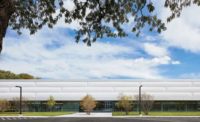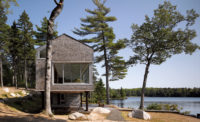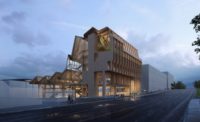From striking houses to a sprawling high school, Marlon Blackwell’s spare, inventively simple buildings are sprinkled throughout Northwest Arkansas. In Fayetteville, his design for an addition to the Fay Jones School of Architecture at the University of Arkansas, where he is a professor, comprises a rectangular volume that mirrors the original Beaux Arts structure in plan, but introduces a contemporary look in elevation. A few miles away in Springdale, Blackwell converted a common metal shed into a surprising Eastern Orthodox church. Now, farther north, in Rogers, Blackwell’s firm, Marlon Blackwell Architects (MBA), again demonstrates how to do more with less in its most recent project.
Additional Content:
Jump to credits & specifications
The Harvey Pediatric Clinic combines the bold geometry and distinctive material palette for which MBA has become known, into a statement-making medical facility that stands out among its suburban neighbors. The long, south-facing, box-ribbed aluminum-zinc alloy exterior wall is painted vivid red—a sharp contrast to the neutral gray of the rest of the building—so that it looks like a billboard along the road. “Everything is beige in the suburbs,” says Blackwell. “We wanted to use color, to add a sense of wonder. The clinic’s staff voted on this mix of cayenne and burnt orange.”
“The exterior is unusual and definitive, but not flamboyant,” says Dr. Bryan Harvey, who hired Blackwell to design the 15,500-square-foot building after attending a tour of modern houses in Fayetteville, which included the L-shaped, cantilevering home that Blackwell designed with his wife and MBA co-principal, Meryati Johari-Blackwell, for their family. Adds Harvey, “We wanted a building that was a stimulus for the kids but also a great work environment for the staff.”
Harvey’s practice, which he runs with several other doctors, is located on the upper level; his nearly 40 employees administer daily to over 150 patients ranging from toddlers to young adults. The design incorporates abundant daylight, outdoor access, and greenery through the use of large windows, skylights, and a second-story porch, with extensive landscaping and a rear patio garden at grade. The fully glazed lower level is rented out to pediatric specialists to whom the Harvey Clinic sends referrals.
Patients enter the steel-frame horizontal structure through a breezeway, accessed via a car dropoff on the north side, or from the parking lot, which MBA kept to the south. The colorful bar is accented by zippy diagonal protrusions that house stairs—like a shoe at the bottom on one end and a hat on top at the other—resulting in an abstract shape. Harvey Clinic patients ascend the first set of stairs to enter the lobby and waiting room; the clinic’s staff use the second set to reach a serene flex space overlooking, but away from, the activity of the office.
“This building doesn’t lean on typical tropes,” Blackwell says. “Its design was discursive rather than prescribed—based on exchange and collaboration with the client, whose approach to medicine is similarly unorthodox.” Over the years, the focus of Harvey’s practice has shifted credits from treating typical childhood ailments to fostering child development and sound mental health. “The question is, ‘How are you helping children grow rather than just survive?’ ” he asks.
The upper level’s floor plan optimizes flow within the busy practice, essentially creating a loop around which patients can circle, beginning with check in, and followed by exam, consultation, and check out. Full-height doors within the nearly 10-foot-tall space punctuate the rhythm of that procession around the 6-foot-wide corridors. Past that loop, at the west end of the building, is the administrative hub, with offices and conference rooms for staff meetings or visits from insurance or pharmaceutical reps. Throughout, white walls set off buffed and sealed concrete floors.
At just under $200 per square foot, the project is economical, yet the architects did not ignore the details—“making craft from off-therack systems,” is how Blackwell describes his approach. The 8-inch-wide flat-seam metal panels that line the breezeway, for instance, are completely coursed with other areas of the facade, all trimmed with a 2½-inch-wide rubber base and a 2 ¾-inch-wide custom break metal for a sharp finish. For MBA, rigor and creativity don’t necessarily come at a cost.
CreditsArchitect: Marlon Blackwell Architects 42 East Center Street Fayetteville, AR 72701
Personnel in architect's firm who should receive special credit: Marlon Blackwell, FAIA / Principal in Charge and Design Architect Meryati Johari Blackwell, AIA, ASID, LEED AP BD+D / Principal Justin Hershberger, AIA / Project Architect Design Team: Scott McDonald; Stephen Kesel, Assoc. AIA; Spencer Curtis, Assoc. AIA; Stephen Reyenga, Assoc. AIA
Engineers Mechanical, Electical, Plumbing: HP Engineering, Inc Structural: Tatum Smith Engineers, Inc Civil: Bates & Associates, Inc.
Consultants Landscape Design: Stuart Fulbright
General contractor: SSI, Inc
Photographer: Timothy Hursley
|
SpecificationsStructural System Steel frame with composite decking: Fig Tree Inc
Exterior Cladding Metal panels: Morin
Roofing Membrane Roof: Firestone Building Products
Glazing Storefront: Kawneer and Ace Glass
Doors Entrances: Kawneer Wood doors: Marshfield Door Systems
Hardware Locksets: Hager Closers: Hager / LCN Exit devices: Kawneer Pulls: Hager Security devices: Best Access Systems
Interior Finishes Acoustical ceilings: CertainTeed Suspension grid: CertainTeed Cabinetwork and custom woodwork: Kitchen Distributors Paints and stains: Sherwin Williams Plastic laminate: Pionite Resilient flooring: Johnsonite Carpet: JJ Invision
Furnishings All furniture provided by owner
Lighting Downlights: Juno (Recessed Cans); Forum (Recessed Linear); Coronet (Troffer) Exterior: Juno Dimming system or other lighting controls: Leviton
Conveyance Elevators/escalators: Otis
Plumbing Drinking Fountain: Elkay Lavatory: American Standard Water Closets: American Standard Sinks: Elkay Faucets: Symmons |














